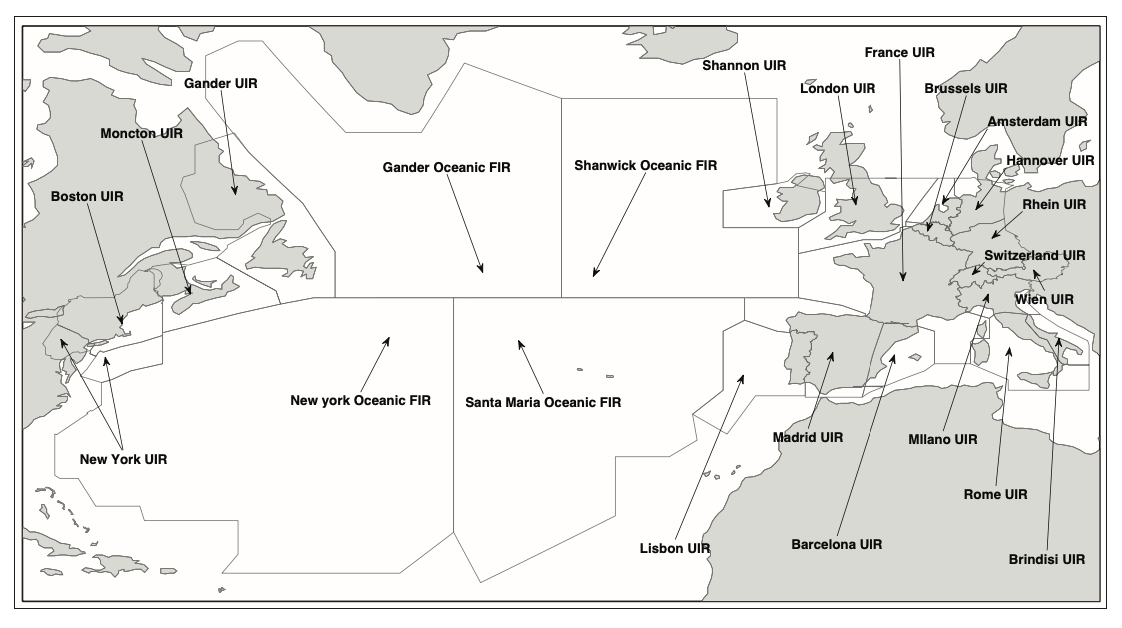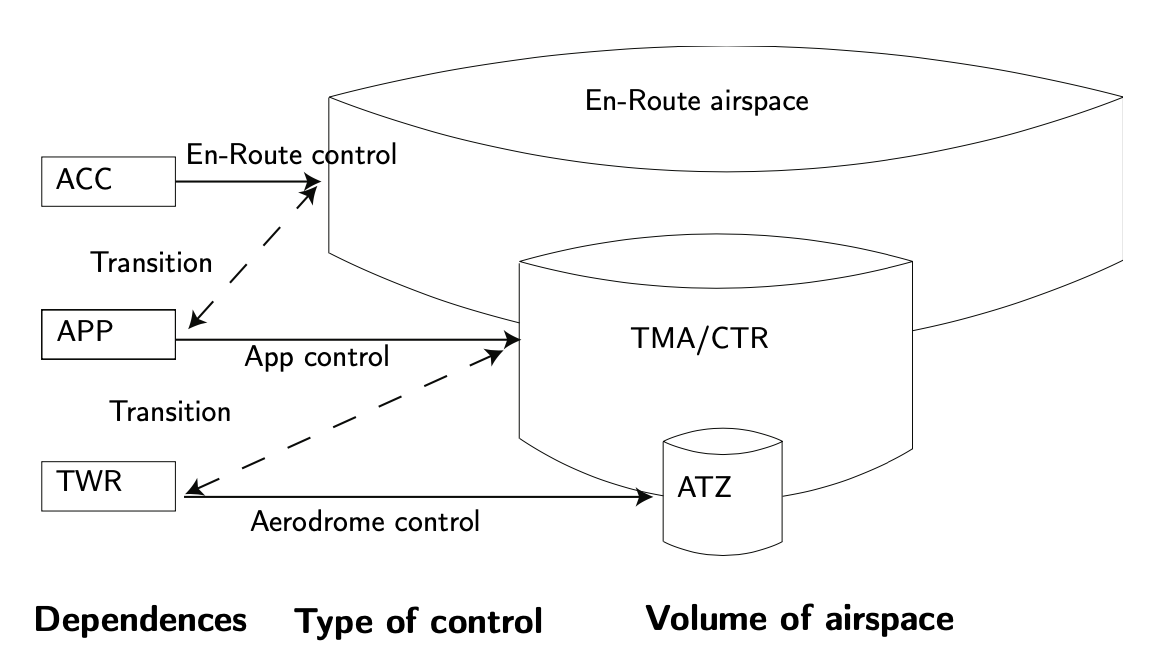10.3.2: Airspace organization in regions and control centers
- Page ID
- 78379
\( \newcommand{\vecs}[1]{\overset { \scriptstyle \rightharpoonup} {\mathbf{#1}} } \)
\( \newcommand{\vecd}[1]{\overset{-\!-\!\rightharpoonup}{\vphantom{a}\smash {#1}}} \)
\( \newcommand{\id}{\mathrm{id}}\) \( \newcommand{\Span}{\mathrm{span}}\)
( \newcommand{\kernel}{\mathrm{null}\,}\) \( \newcommand{\range}{\mathrm{range}\,}\)
\( \newcommand{\RealPart}{\mathrm{Re}}\) \( \newcommand{\ImaginaryPart}{\mathrm{Im}}\)
\( \newcommand{\Argument}{\mathrm{Arg}}\) \( \newcommand{\norm}[1]{\| #1 \|}\)
\( \newcommand{\inner}[2]{\langle #1, #2 \rangle}\)
\( \newcommand{\Span}{\mathrm{span}}\)
\( \newcommand{\id}{\mathrm{id}}\)
\( \newcommand{\Span}{\mathrm{span}}\)
\( \newcommand{\kernel}{\mathrm{null}\,}\)
\( \newcommand{\range}{\mathrm{range}\,}\)
\( \newcommand{\RealPart}{\mathrm{Re}}\)
\( \newcommand{\ImaginaryPart}{\mathrm{Im}}\)
\( \newcommand{\Argument}{\mathrm{Arg}}\)
\( \newcommand{\norm}[1]{\| #1 \|}\)
\( \newcommand{\inner}[2]{\langle #1, #2 \rangle}\)
\( \newcommand{\Span}{\mathrm{span}}\) \( \newcommand{\AA}{\unicode[.8,0]{x212B}}\)
\( \newcommand{\vectorA}[1]{\vec{#1}} % arrow\)
\( \newcommand{\vectorAt}[1]{\vec{\text{#1}}} % arrow\)
\( \newcommand{\vectorB}[1]{\overset { \scriptstyle \rightharpoonup} {\mathbf{#1}} } \)
\( \newcommand{\vectorC}[1]{\textbf{#1}} \)
\( \newcommand{\vectorD}[1]{\overrightarrow{#1}} \)
\( \newcommand{\vectorDt}[1]{\overrightarrow{\text{#1}}} \)
\( \newcommand{\vectE}[1]{\overset{-\!-\!\rightharpoonup}{\vphantom{a}\smash{\mathbf {#1}}}} \)
\( \newcommand{\vecs}[1]{\overset { \scriptstyle \rightharpoonup} {\mathbf{#1}} } \)
\( \newcommand{\vecd}[1]{\overset{-\!-\!\rightharpoonup}{\vphantom{a}\smash {#1}}} \)
\(\newcommand{\avec}{\mathbf a}\) \(\newcommand{\bvec}{\mathbf b}\) \(\newcommand{\cvec}{\mathbf c}\) \(\newcommand{\dvec}{\mathbf d}\) \(\newcommand{\dtil}{\widetilde{\mathbf d}}\) \(\newcommand{\evec}{\mathbf e}\) \(\newcommand{\fvec}{\mathbf f}\) \(\newcommand{\nvec}{\mathbf n}\) \(\newcommand{\pvec}{\mathbf p}\) \(\newcommand{\qvec}{\mathbf q}\) \(\newcommand{\svec}{\mathbf s}\) \(\newcommand{\tvec}{\mathbf t}\) \(\newcommand{\uvec}{\mathbf u}\) \(\newcommand{\vvec}{\mathbf v}\) \(\newcommand{\wvec}{\mathbf w}\) \(\newcommand{\xvec}{\mathbf x}\) \(\newcommand{\yvec}{\mathbf y}\) \(\newcommand{\zvec}{\mathbf z}\) \(\newcommand{\rvec}{\mathbf r}\) \(\newcommand{\mvec}{\mathbf m}\) \(\newcommand{\zerovec}{\mathbf 0}\) \(\newcommand{\onevec}{\mathbf 1}\) \(\newcommand{\real}{\mathbb R}\) \(\newcommand{\twovec}[2]{\left[\begin{array}{r}#1 \\ #2 \end{array}\right]}\) \(\newcommand{\ctwovec}[2]{\left[\begin{array}{c}#1 \\ #2 \end{array}\right]}\) \(\newcommand{\threevec}[3]{\left[\begin{array}{r}#1 \\ #2 \\ #3 \end{array}\right]}\) \(\newcommand{\cthreevec}[3]{\left[\begin{array}{c}#1 \\ #2 \\ #3 \end{array}\right]}\) \(\newcommand{\fourvec}[4]{\left[\begin{array}{r}#1 \\ #2 \\ #3 \\ #4 \end{array}\right]}\) \(\newcommand{\cfourvec}[4]{\left[\begin{array}{c}#1 \\ #2 \\ #3 \\ #4 \end{array}\right]}\) \(\newcommand{\fivevec}[5]{\left[\begin{array}{r}#1 \\ #2 \\ #3 \\ #4 \\ #5 \\ \end{array}\right]}\) \(\newcommand{\cfivevec}[5]{\left[\begin{array}{c}#1 \\ #2 \\ #3 \\ #4 \\ #5 \\ \end{array}\right]}\) \(\newcommand{\mattwo}[4]{\left[\begin{array}{rr}#1 \amp #2 \\ #3 \amp #4 \\ \end{array}\right]}\) \(\newcommand{\laspan}[1]{\text{Span}\{#1\}}\) \(\newcommand{\bcal}{\cal B}\) \(\newcommand{\ccal}{\cal C}\) \(\newcommand{\scal}{\cal S}\) \(\newcommand{\wcal}{\cal W}\) \(\newcommand{\ecal}{\cal E}\) \(\newcommand{\coords}[2]{\left\{#1\right\}_{#2}}\) \(\newcommand{\gray}[1]{\color{gray}{#1}}\) \(\newcommand{\lgray}[1]{\color{lightgray}{#1}}\) \(\newcommand{\rank}{\operatorname{rank}}\) \(\newcommand{\row}{\text{Row}}\) \(\newcommand{\col}{\text{Col}}\) \(\renewcommand{\row}{\text{Row}}\) \(\newcommand{\nul}{\text{Nul}}\) \(\newcommand{\var}{\text{Var}}\) \(\newcommand{\corr}{\text{corr}}\) \(\newcommand{\len}[1]{\left|#1\right|}\) \(\newcommand{\bbar}{\overline{\bvec}}\) \(\newcommand{\bhat}{\widehat{\bvec}}\) \(\newcommand{\bperp}{\bvec^\perp}\) \(\newcommand{\xhat}{\widehat{\xvec}}\) \(\newcommand{\vhat}{\widehat{\vvec}}\) \(\newcommand{\uhat}{\widehat{\uvec}}\) \(\newcommand{\what}{\widehat{\wvec}}\) \(\newcommand{\Sighat}{\widehat{\Sigma}}\) \(\newcommand{\lt}{<}\) \(\newcommand{\gt}{>}\) \(\newcommand{\amp}{&}\) \(\definecolor{fillinmathshade}{gray}{0.9}\)As mentioned in the introduction of the section, ATS routes go through regions that determine the volumes of responsibility over which the functions of surveillance and control are executed. These regions are referred to as FIR/UIR (Flying Information Region/Upper Information Region).

Figure 10.9: UIRs in the North Atlantic region and western Europe.
FIR regions cover an area of responsibility of a state up to 24500 feet (FL245). Over a FIR, it is defined an UIR, which covers flight levels above FL245. The UIR had to be defined when jets appeared. Notice that jets, opposite to propellers, flight more efficiently in upper flying levels. Typically the geographical area (surface on earth) for both FIRs and UIRs coincide. Figure 10.9 shows the FIR/UIR structure for the North Atlantic region and western Europe in the upper level. In the case of Spain, there are three FIR/UIR regions of responsibility:
- Barcelona FIR/UIR.
- Madrid FIR/UIR.
- Canarias FIR/UIR.
The need for surveillance and control inside FIR/UIR regions differs depending on the phase of the flight. Specifically, there are different needs when the aircraft is cruising (typically with stationary behavior) rather that when the aircraft is in the vicinity of an airport (either departing or arriving). Therefore, we can define different areas inside a FIR/UIR:
- En-Route airspace: Volumes of airspace containing airways connecting airports’ TMA (Terminal Maneuvering Areas), i.e., volumes containing the network of ATS routes.
- TMA: Volumes of airspace situated above one or more airports. In the TMA are located the SIDs12 and STARs procedures that allow aircraft to connect airways with the runway when departing or arriving.
- CTR (Control zone, also referred to as transit zone): The CTR is inside a TMA, it is a volume of controlled airspace around an airport where air traffic is operating to and from that airport. Aircraft can only fly in it after receiving a specific clearance from air traffic control. CTRs contains ATZs.
- ATZ (Aerodrome Traffic Zone): ATZ are zones around an airport with a radius of 2 nm or 2.5 nm, extending from the surface to 2,000 ft (600 m) above aerodrome level. Aircraft within an ATZ must obey the instructions of the tower controller.
The labour of surveillance and control can be also divided in three levels as follows:
- En-Route control (also termed area control): executed over the En-Route airspace.
- Approximation control: executed over the CTR and TMA.
- Aerodrome control: executed over the ATZ.

Figure 10.10: Control dependences, type of control and volumes of airspace under control.
This labour is carried out in different dependences:
- Control towers (TWR), where the aerodrome control is executed.
- Approximation offices (APP), where the approximation control is executed.
- Area Control Centers (ACC), where the en-route (area) control is executed.
Every airport has a control tower to host controllers and equipment so that surveillance, communications, and control is provided to aircraft when departing and arriving. Typically, the aerodrome control includes taxiing operations, take-off and landing, and its dependences are on the control tower (with the controller on the top with complete vision of the aerodrome). The initial climb and the approach phases are controlled within the approximation control level, which dependences are typically located in the base of the control tower. The area control level is provided from the so called ACC, which are not typically located in airports. For instance, in Spain there are five ACCs: Barcelona and Palma de Mallorca in FIR/UIR Barcelona; Madrid and Sevilla in FIR/UIR Madrid; Canarias in FIR/UIR Canarias.
Therefore, the airspace is divided and assigned to control dependences so that controllers can provide surveillance, communications, and control services (ATC services), and thus aircraft operate safely. When the traffic within an airspace portion assigned to a control dependence exceeds the capacities of the controller to carry out his/her duty with safety, such dependencies are divided in what is known as ATC sectors. In this way, the separation between all aircraft within an ATC sector is responsibility of a controller.
He/She gives the proper instructions to avoid any potential conflict, and also coordinates the aircraft transfer between his/her sector and adjoining sectors. Obviously, the dimensions of the sector are determined by both the volume of traffic and the characteristics of it.
12. SID and STAR will be studied in Section 10.6.3.


